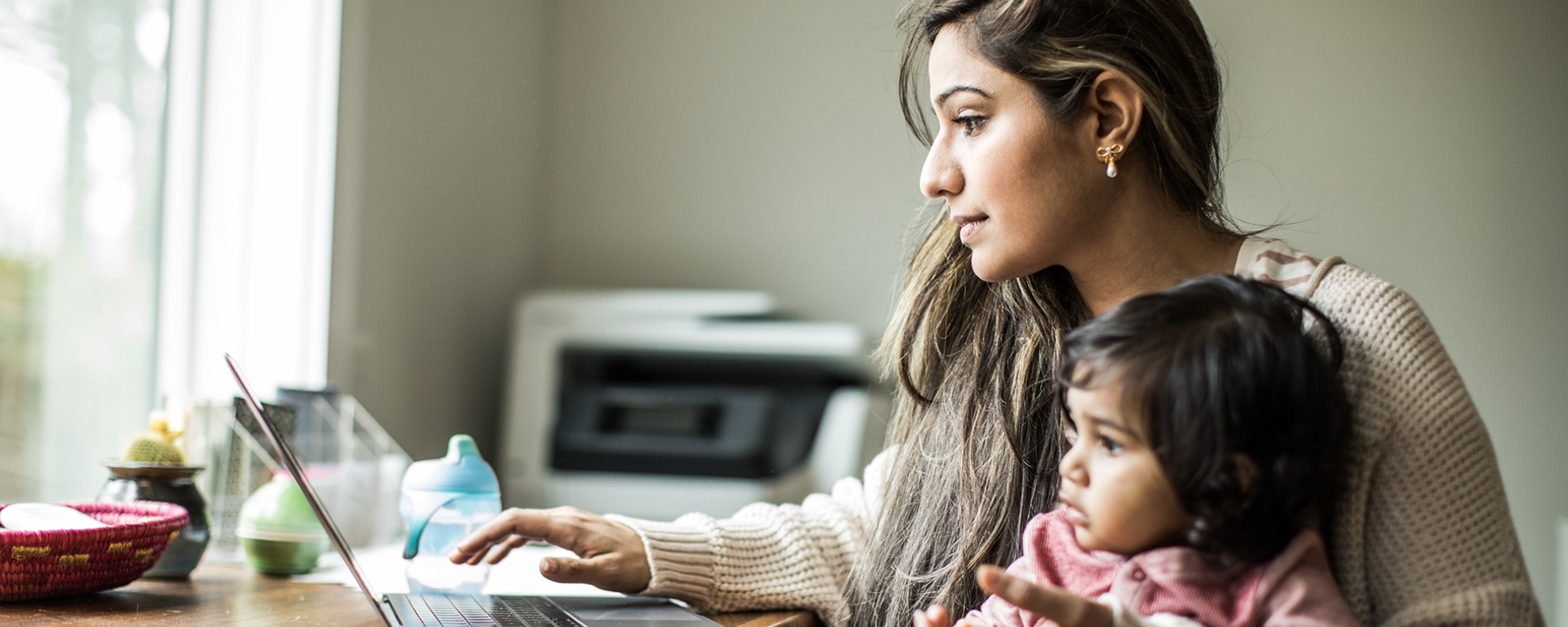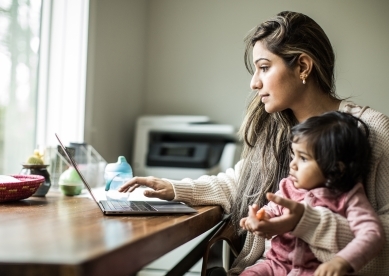
Four female executives share their recent experiences.
How COVID Has Changed Working Women’s Worlds
by Chris Gilbert, M.D., Ph.D.
Are there unexpected positive changes for women forced to work from home because of the COVID-19 pandemic?
To know the answer, I interviewed four executive women:
Marie Steinman, Senior Vice President/Investments at Stifel and mother of four children, ages 8, 9, 11, and 12, said:
“Before the pandemic, my kids didn’t do many chores in the house but when I started to work from home during the pandemic, I became overwhelmed with the combination of housework, and maintaining a quiet house that would allow me to work from home while keeping everyone occupied. I quickly realized I had to start delegating and time blocking.”
Marie observed: “Just like in a teamwork environment where everyone has goals, timelines, and rewards, I gave each kid their goals (laundry, cleaning, folding, and cooking) and timelines after some individual training. Usually, people work towards a paycheck or a bonus. I treated the children the same way and kept a tally of their weekly allowance of $5. They liked seeing their savings grow over time. I even encouraged them not to spend their allowance but 'save it' and collect an extra $5 for saving. Now each child washes their own clothes. They all feel good about keeping their space organized and clean, and they are proud to be able to cook Thai, Italian meals, or bake cakes for the family."
Marie added: “To keep the house quiet, I also came up with ‘time blocking’ sessions where everyone does math or science on the computer or does quiet reading until meals and “recess” time. The children have become much more responsible, independent, and while the stress of multitasking is still present, the trade-off has been a greater quality of life overall, increased quality family time, and tighter emotional ties between family members. All this time that used to be spent on commuting is now extra time for family game nights or daily morning jogs with the children.”
Rachel Roberts, a Palo Alto Networks sales executive running diverse teams at a national level, also had positive feedback from working from home and said:
“Before the pandemic, I often felt torn between my work and family responsibilities because I used to travel an average of three days per week. Especially when my son was younger, it was an everyday struggle to manage his schedule, academic needs, and an equally demanding work calendar. I often felt guilty for not being present enough for my family when I was at work and not present enough for my work team when I was managing family demands. I've seen this same struggle play out with many of my colleagues.”
Rachel continued: “Now, the pandemic and the fact that everyone is working from home, including our customers, offer me the unique opportunity to find the right balance between my family life and my work life. I’m not traveling anymore, and my schedule is more flexible during the day to accommodate my customer’s and my team’s working schedule.”
Rachel described “Flexwork”: “From a corporate stance, we're practicing what we call 'Flexwork,' which gives employees the chance to define their own working days, hours, and location. That’s an awesome step forward for the primary caregiver in the home. For example, sometimes our internal video calls are late in the evening in order to be flexible with working parents who don't have childcare, and sometimes calls are brutally early or on Saturdays.”
When asked about her family life, Rachel said: “I’ve found in this new normal, since my partner and I are both working from home and both of our work calendars can be erratic, we have become more giving and more understanding of each other. Now, we both participate equally in trading off on home tasks like laundry and dishes (there’s a lot of dishes with no restaurants open!) and the needs of our blended family.”
For Rachel, new questions arose: “Since most customer sales meetings are via video conferencing, we get to see inside our customers’ living space and there is a greater degree of intimacy with this blend of home and work. But how do we balance this sense of intimacy and maintain professionalism when working from home? How personal can and should our conversations be?”
Rachel went on to say: “While we’ve all had a kid or pet (or spouse) interrupt a video call—that’s expected—I’ve also seen women step away while the camera is on saying they 'need to move the laundry' or they’ve joined a video conference in their loungewear with an unmade bed in the background. The balance between human authenticity and professionalism may be shifting, finally, in a better direction, but I think it’s important that we don’t step too far over the line and become casual with our customers or our careers.”
Shira Harrison, vice president of information technology for Amblin Networks, shared Marie and Rachel’s point of view about the unique opportunity for women to balance work and family life.
Shira said: “Before the pandemic, being a female parent of young children was viewed negatively but now, with the work from home new normal, everything is leveling up. Men and women are working on a keyboard from home. People are more tolerant of seeing kids, dogs, and cats in the background and between team members, there is more emotional closeness despite the physical distancing.
Shira added: “Results are what matters, not gender anymore. Women are as capable as men and this shows now more than ever since both men and women are forced to work from home. Women, because they are often used to raising children, are organized, good at multitasking, and make great managers. In addition, women don’t panic in difficult situations, are usually perceptive if an employee is not doing well, and are understanding if an employee needs to attend to his or her kids.”
When asked if she had any unexpected happy surprise, Shira smiled: “One unexpected thing happened with my daughter that would never have happened before the pandemic. My 15-year-old daughter, before the pandemic, said she wanted to be a nurse but after being in the background for some of my video conferencing work meetings, she became very interested in my work and is now thinking of having a career in information technology. This makes me very happy."
Last week, I asked another entertainment executive, Nadya Ichinomiya, creator of the Agile Center of Excellence at Sony Pictures Entertainment and chairwoman of WITH (Women in Technology: Hollywood), for her point of view. Nadya said:
“At Sony Pictures, we know how to find advantage in adversity, so when the pandemic hit, we all came together, thanks to our nurturing leaders. It became a catalytic moment where everyone instantly became laser-focused, intensely leaning into the existing emotional bonds of trust to take our collaboration to the next level. We all went into calm execution mode, being fairly grounded in the face of the volatility. The pandemic brought out the best in us and working from home made us emotionally closer to each other.”
Nadya added: “Not only am I now emotionally closer to my work team, but I am also closer to my two sons and my husband. Unfortunately, Mingus, my 14-year-old son, lost Dolphy, our 13-year-old Boston Terrier a month ago. Mingus and Dolphy had grown up together ever since Mingus was one year old. They were best friends and had become inseparable during the pandemic. When Dolphy died, Mingus went into shock and deep sadness for over two weeks. That was my son’s first time experiencing intense grief and it was very difficult to witness. Because I was working from home, I was able to be there for Mingus which I wouldn’t have been able to do before the pandemic.”
Talking to those four executive women, I realized that a year of pandemic and of a new normal of working from home has triggered some very positive changes for them:
- More equality between men and women at work.
- More satisfaction for women working from home, being able to more effectively multitask and juggle work and family life.
- More emotional ties between team members despite more physical distancing.
- More mutual respect, understanding, and task-sharing between spouses.
- Children witnessing their parents’ work and possibly getting more interested in it.
- Children being more responsible for doing house chores.
- Better able to address children’s needs in case of crisis.
- More family togetherness and harmony.
The question is: What will happen when the pandemic is over? Will some companies realize that they can decrease their overhead by having smaller office spaces and keep people working from home a few days a week? Will women determine that working from home is the way to go when you have young children at home?
It is possible that this COVID-19 pandemic has a silver lining for women, making them realize that they can efficiently balance family life and work life when they work from home so that they can blossom to their full potential.
This is the beauty of turning something negative like a pandemic into something incredibly positive: a different way of working for the greatest family and work satisfaction combined.

